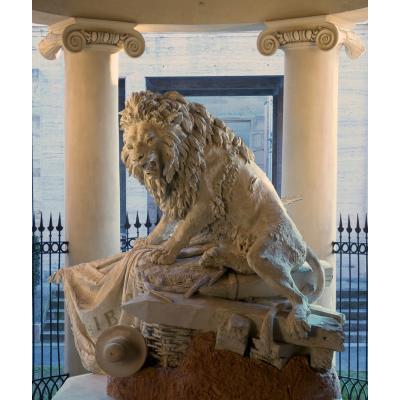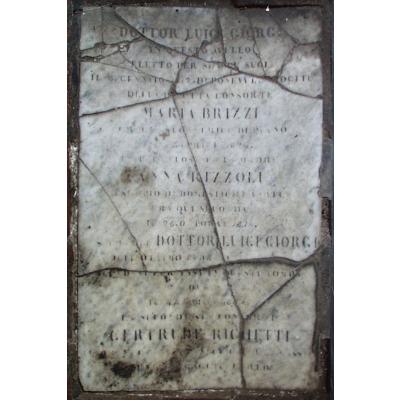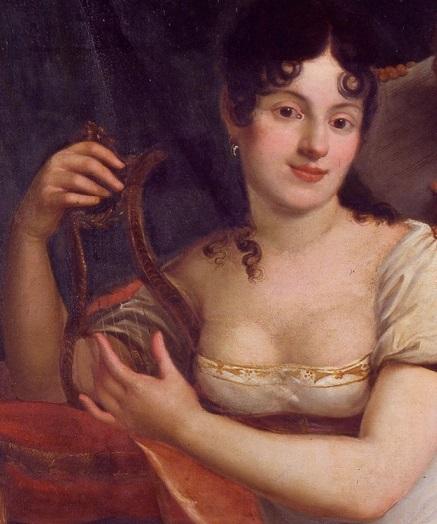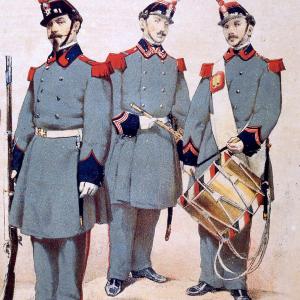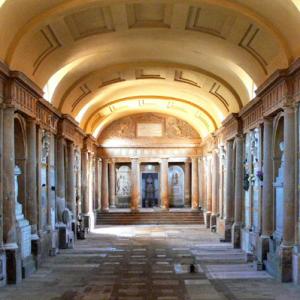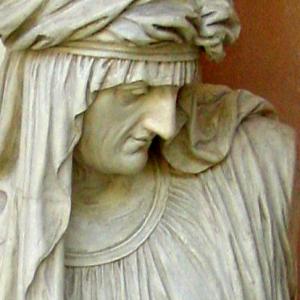Scheda
Maria Brizzi Giorgi (1775 - 1812), pianist and composer, was born in the Palazzo Albergati on Via Saragozza, she had two brothers who also became famous musicians, and already as a child Maria’s musical talent was appreciated, to the point that only at thirteen years old she was the organist and choir master of an important monastery in Ancona. In February 1794, at the age of nineteen, she married the lawyer Luigi Giorgi, whose family owned the Aurora Cafe on Via San Mamolo in Bologna, on the corner of Via della Asse, the street where Maria and Luigi would live and where, later, the Polimniaca Academy will be located. Alongside such a politically engaged husband like Luigi Giorgi, Maria put her art to the service of the Revolution, and to good use, as the composition of the Marcia put to music is entrusted to her, says Giordani, Bologna was the first place the soldiers wore their tricolor uniform: “It was nice to see the Bolognese youth training to the music of such a beautiful twenty year-old woman for two years: beautiful to hear her music greeting the first feats of the Italian militia…” During the Austro-Russian occupation of Bologna (1799-1800), she and her husband moved outside of the city and were invited by her father to live with his brother, Antonio, near the imperial court of Vienna, a city where one of her concerts was reviewed in 1805 by the “Allgemeine Musikalische Zeitung”. Their return to Bologna marked the beginning of Maria’s brighter artistic phase that, in 1806, granted her the title of the acclaimed Academia Filarmonica, she is also admitted to the Accademia dei Concordi and she starts the Polimniaca Academy.
The Polimniaca Academcy was a school for piano and singing, as well as a concert venue in which the beautiful world of Bologna would participate. Antonio Bacchetti remembers: "the most famous scholars, the clearest masters of singing and sound would come running to the competition as a rich and happy source to experience the good taste, the grace and the exquisite art: and her house, almost converted into an Arcadia, or rather a new Parnassus, was the refuge and pleasant place for the festivities of joy and delight. By increasingly promoting the growth and perfection of the art, under the name of the Polimniaca Accademia, she has a recipe to bring the most renowned professors, who come for the day determined to experience the most selective pieces of ancient and modern music, voices and instruments together. The glorious passings and happy remembrances of remarkable men and of the equally illustrious women intertwined with sweet dispositions, that there was no one by birth, by rank, and by nature, or so grave and delicate, or so difficult and reluctant, that they did not come to the meeting desperate and blessed for those hours, which were happy and rapid as the bosom of harmony flowed and all the senses and harmonies ravished, and were always intoxicated with various serious or tender emotions."
It is also a meeting and transition point for cultural, musical, and political personalities from all over Europe, particularly those of the French language, as an art salon where it was possible to meet with the most illustrious Bolognese, to listen to the music unknown by most Italian and admire international artists. It was at the Polimniaca Accademy, on 31 July 1806, when the young Gioachino Rossini performed for the first time in Bologna and then who, on 23 December 1808, he presented his first symphony and received his first important review as a composer: "The Academy of Music could neither be brighter nor more appreciated: the Academy opened with a symphony composed by Maestro Gioachino Rossini, from the Philharmonic Academy, a man of great hopes. It was found harmonious beyond all belief. His genre was completely new and he received universal applause." However, Brizzi’s activities as a composer, organiser, and concertist is not only at her Academy (which will close in 1809 when the Giorgi family moves to Via San Felice n. 70): the artist is the main face of the first chamber concert performed at the Teatro Comunale that we know of, when "the unique piano player enchanted the audience into silence" She was the center of attention at the Accademia dei Concordi (which, from 1807, was under the guidance of Tommaso Marchesi, acting with the Liceo Musical and presented Gioachino Rossini as a master of the harpiscord) and at the Casino Society. It is during these concerts at the Casino that on March 19, 1811, Maria performs for the last time in public: if the other Academies were beautiful, this one must have been beautiful because of the combination of events that made it so unique. Excellent musicians were in attendance, but they voluntarily would give their first praise to the famous Paganini violinist who played so rarely that some had difficulty to favour Kreutzer more, who performed a concert so divine, it intoxicated the soul and moved people out of their senses. He triumphed more so when he joined Maria Giorgi’s Accademia’s piano player, while she, not paying much attention to her health conditions, went to the Academy as a delightful surprise from the Society and at whim she played with the Paganini the themes of Paisiello in the Cor. After which she performed a small concert by Maestro Pavesi to which she received much praise.
By now Maria was suffering from a difficult pregnancy; she would play her last notes only for friends and relatives that surrounded her during her last moments of life, as Giordani tells us again; the last of her human works and it was able to give comfort to the grieving family: that she was already very close to giving birth, already in labor, when she got up and went to the room with a few of her friends, regretting her dangerous labor, her eldest daughter played to attempt to deceive the pain. Quivi Marietta, asked her friends to be courageous, concealing the torments she suffered, she wanted the Paisiello motif to sound as affectionate as the concerts in her mind, fully of melancholy, so sweet that it made those who understood them to cry. But she did not mingle with the tears she caused and she returned to the bed she would never arise from and she said these words, that she would now die happy after consoling and bringing some delight to her husband and her family. Then she asked her daughter how she would remember those sounds but she interrupted herself and she resented herself (so much it cannot be told) and expressed a brief restitution of her soul, so she turned to her beloved that she would never see again; begging her Teresina to take the most expensive things. She was assisted by two great Bolognese doctors, Gaspare Uttini an Matteo Venturoli, and died on 7 January 1812, a few days after giving brith to her son Eugenio.
Seven days after her death, Francesco Tognetti traced the biography and artistic career of the woman in the famous obituary and refers to how "the lament of every order of people made known how much the illustrious Donna was loved". Eleven months after her death, on December 1, 1812, the music in Bologna stoped to pay her tribute: the Philharmonic Academy organised a concert in San Giovanni in Monte, the Accademia dei Concordi played a cantata specially composed by the German Johann Kaspar Aiblinger performed by Domenico Mombelli and Teresa Giorgi Belloc (who will come again in Rossini’s story), the Casino Society, finally “wanted music and poems to praise and celebrate her”. Two years after her death, Luigi Giorgi remarried, on December 22, 1814 with the Bolognese singer Geltrude Righetti, who took the name of her husband, a fact that started a series of fatal misunderstandings in the musical historiography of the two musicians. Maria Brizzi Giorgi is buried in a simple tomb at the foot of the Monument of the Martyrs of Independence in the Hall of the Tombs at the Certosa monumaental cemetery of Bologna.
Translation from italian language by Holly Bean.


